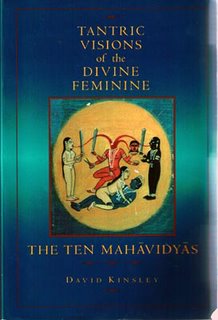
Books: Tantric Visions of the Divine Feminine by David Kinsley
This is a fairly scholarly and dense book that explores the ten Mahavidyas, or hindu goddesses. These goddesses exist as individual goddesses and, since the early medieval period, as a group. Its important to note, however, that while they're listed and discussed as distinct divinities, they're also just manifestations of the godhead, the Mahadevi or great goddess. Written by David Kinsley, professor of Religion at Canada's McMaster University until his death in 2000, the book attempts to reconcile the grotesque and violent nature with their role as vehicles for awakening.
The ten goddesses are:
Kali, The Black Goddess
Tara: The Goddess Who Guides Through Troubles
Tripura-sundari, She Who Is Lovely In Three Worlds
Bhuvanesvari, She Whose Body Is The World
Chinnamasta, The Self-Decapitated Goddess
Bhairavi, The Fierce One
Dhumavati, The Widow Goddess
Bagalamukhi, The Paralyzer
I've dipped into and out of this book so many times since I first came across it in early 2000. At first I was only interested in Kali--the one in whom womb and tomb are joined. Most are either familiar with Kali-Ma: that dark goddess with hundreds of breasts, a necklace of skulls, dancing on the prone body of a wimpy male. She's your inner beast come to life... Truth is, during the first draft of my novel I was obsessed with Kali and included her as a sort of minor character. (In that draft, Kali is the focus of Jasmine's aunt's ongoing hallucinations. In the second draft I excised Kali and created my own violent goddess figure and wove her mythologies into the pretty traditional literary suspense narrative.) But I spent a good 6 months reading everything about Kali that I could. At that time I was a morbidly shy and serious writer. I struggled with a sort of passive depression and spent way too many nights drinking red wine, smoking both cigarettes and marijuana in turn. I think, looking back on it, that the violence Kali enacted on the world mirrored the violence I enacted on myself daily.
But that's a discussion for another day.
Six years (or three drafts) later, I don't smoke cigarettes, only rarely share a joint with a friend and have sworn off alcohol. I spend more time at the gym and yoga studio than I do watching TV and if you find me at a bar I'll be drinking either hot tea or seltzer, depending on the season.
My life has changed and so have the forms of mahadevi that I'm attracted to.
So Lately I've been thinking more about Tara. Well, specifically about Kuan Yi & Tibetan Tara and connecting/contrasting them with Mrs. Ramsey in Woolf's To The Lighthouse and Mrs. Stevens from May Sarton's Mrs. Stevens Hears The Mermaid Singing.
So I started rereading Kinsley's book when I work my 6:00 AM shift at the Yoga studio Tuesdays and Thursdays. (So quiet there--and after I light the incense and pour my tea, I sit down and read a paragraph or two.)
And so I came across this phrase that I've been thinking about on and off for the last few days: "The theological idea is that ulitmate reality, which is female in essence and form, displays herself in a great variety of ways for different purposes."
This is a huge statement: not just that ultimate reality contains male and female elements/energies/divinities or whichever word you'd feel most comfortable, but that reality is feminine at core.

0 Comments:
Post a Comment
Subscribe to Post Comments [Atom]
<< Home